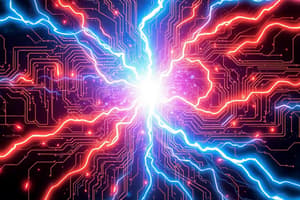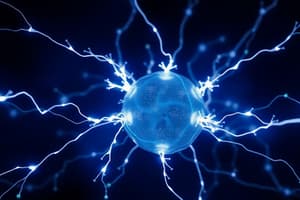Podcast
Questions and Answers
What is the primary difference between electrical energy and electricity?
What is the primary difference between electrical energy and electricity?
- Electrical energy results from the movement of electrons, while electricity is the flow of that energy through conductors. (correct)
- Electrical energy is a form of electricity.
- Electrical energy is static, while electricity is dynamic.
- Electrical energy is measured in Volts, whereas electricity is measured in Joules.
Which type of energy is static electricity classified as?
Which type of energy is static electricity classified as?
- Kinetic energy
- Potential energy (correct)
- Thermal energy
- Mechanical energy
How is the magnetic field around a current-carrying conductor affected?
How is the magnetic field around a current-carrying conductor affected?
- It depends on the direction of the electric current flowing through the wire. (correct)
- It is independent of the direction of electric current.
- It is determined by the type of material in the conductor.
- It is dependent on the voltage applied to the circuit.
What unit is used to measure electric power?
What unit is used to measure electric power?
Which example does NOT represent a form of electrical energy?
Which example does NOT represent a form of electrical energy?
What happens when a sufficient charge builds up in static electricity?
What happens when a sufficient charge builds up in static electricity?
What is the relationship between electricity and magnetism known as?
What is the relationship between electricity and magnetism known as?
What is measured in Coulombs?
What is measured in Coulombs?
Which of the following units is associated with energy in electrical systems?
Which of the following units is associated with energy in electrical systems?
What occurs when electricity flows from one place to another?
What occurs when electricity flows from one place to another?
What is the primary force responsible for electrical energy?
What is the primary force responsible for electrical energy?
How does the speed of electric charges affect the amount of electrical energy they carry?
How does the speed of electric charges affect the amount of electrical energy they carry?
Which of these is NOT a component of an atom?
Which of these is NOT a component of an atom?
What is the name given to the outermost shell of an atom?
What is the name given to the outermost shell of an atom?
Why are valence electrons more likely to be involved in electrical energy production?
Why are valence electrons more likely to be involved in electrical energy production?
Which of these statements accurately describes the relationship between electrons and electrical energy?
Which of these statements accurately describes the relationship between electrons and electrical energy?
What is the main characteristic of materials that are good conductors of electricity?
What is the main characteristic of materials that are good conductors of electricity?
What type of materials allow electrons to move freely through them?
What type of materials allow electrons to move freely through them?
What is the relationship between the number of electrons in an atom's shells and the atom's ability to conduct electricity?
What is the relationship between the number of electrons in an atom's shells and the atom's ability to conduct electricity?
Which of the following is NOT an example of how we rely on electrical energy in our daily lives?
Which of the following is NOT an example of how we rely on electrical energy in our daily lives?
Flashcards are hidden until you start studying
Study Notes
Electrical Energy Overview
- Electrical energy is generated by the movement of electric charges.
- It is essential for daily activities, powering devices like alarm clocks and vehicles.
- Energy is defined as the ability to perform work or exert force.
Atom Structure and Charge Movement
- An atom consists of a nucleus with protons (positively charged) and neutrons (neutral).
- Electrons (negatively charged) orbit the nucleus in shells, with specific capacity limits:
- 1st shell: 2 electrons
- 2nd shell: 8 electrons
- 3rd shell: up to 18 electrons
- Valence electrons, located in the outermost shell, can easily move, allowing electrical energy flow between atoms.
Conductors and Insulators
- Conductors (e.g., metals) permit free movement of electrons, enhancing electrical flow.
- Insulators (e.g., plastic, glass) restrict electron movement, preventing electrical flow.
Electrical Energy vs. Electricity
- Electrical energy results from electron movement and is measured in Joules.
- Electricity, measured in Watts, refers to the flow of electric energy through a conductor.
- Static electricity: charge accumulation in one location; current electricity: flow of charge powering devices.
- Example of static electricity: rubbing a balloon on hair creates oppositely charged objects.
Electromagnetism
- The flow of electric current around a wire generates a magnetic field.
- Electromagnetism describes the mutual interaction between electricity and magnetism.
Key Units of Electrical Energy
- Ampere (A): Electric current
- Coulomb (C): Electric charge
- Farad (F): Capacitance
- Henry (H): Inductance
- Hertz (Hz): Frequency
- Ohm (Ω): Resistance
- Joule (J): Energy
- Kilowatt-hour (kWh): Energy (larger scale)
- Volt (V): Electric potential difference
- Watt (W): Electric power
Potential Energy vs. Kinetic Energy
- Electrical energy can manifest as potential energy (stored energy) or kinetic energy (energy in motion).
- Static electricity showcases potential energy that converts to kinetic upon discharge (e.g., spark).
- Batteries store electric energy (potential) until used, transforming to kinetic energy when activated.
Examples of Electrical Energy
- Batteries power electronic devices.
- Electric charges in wires supply power to appliances like TVs and computers.
- Static electricity generates effects from charge imbalance.
- Capacitors store energy within an electric field for later use.
Studying That Suits You
Use AI to generate personalized quizzes and flashcards to suit your learning preferences.




